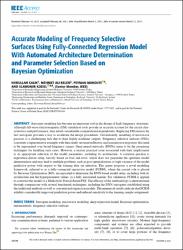| dc.contributor.author | Çalık, Nurullah | |
| dc.contributor.author | Belen, Mehmet Ali | |
| dc.contributor.author | Mahouti, Peyman | |
| dc.contributor.author | Koziel, Slawomir | |
| dc.date.accessioned | 2022-01-11T10:45:19Z | |
| dc.date.available | 2022-01-11T10:45:19Z | |
| dc.date.issued | 2021 | en_US |
| dc.identifier.citation | Calik, N., Belen, M.A., Mahouti, P., Koziel, S. (2021). Accurate modeling of frequency selective surfaces using fully-connected regression model with automated architecture determination and parameter selection based on bayesian optimization
IEEE Access, 9, pp. 38396-38410. | en_US |
| dc.identifier.uri | https://hdl.handle.net/20.500.12508/2091 | |
| dc.description.abstract | Surrogate modeling has become an important tool in the design of high-frequency structures. Although full-wave electromagnetic (EM) simulation tools provide an accurate account for the circuit characteristics and performance, they entail considerable computational expenditures. Replacing EM analysis by fast surrogates provides a way to accelerate the design procedures. Unfortunately, modeling of microwave passives is a challenging task due to their highly-nonlinear outputs. Frequency selective surfaces (FSSs) constitute a representative example with their multi-resonant reflection and transmission responses that need to be represented over broad frequency ranges. Deep neural networks (DNNs) seem to be the promising techniques for handling such cases. However, a serious practical issue associated with their employment is an appropriate selection of the model parameters, including its architecture. A common practice is experience-driven setup, heavily based on trial and error, which does not guarantee the optimum model determination and may lead to multiple problems such as poor generalization or high variance of the model predictive power with respect to the training data set selection. This paper proposes a novel modeling framework, referred to as a fully-connected regression model (FCRM), where the crucial role is played by Bayesian Optimization (BO), incorporated to determine the DNN-based model setup, including both its architecture and the hyperparameter values, in a fully automated manner. For validation, FCRM is applied to construct the model of a Minkowski Fractal-Based FSS. The efficacy of the methodology is demonstrated through comparisons with several benchmark techniques, including the DNN surrogates established using the traditional methods as well as conventional regression models. The numerical results indicate that FCRM exhibits considerably improved prediction power and reduced sensitivity to the training sample assignment. | en_US |
| dc.language.iso | eng | en_US |
| dc.publisher | Institute of Electrical and Electronics Engineers Inc. | en_US |
| dc.relation.isversionof | 10.1109/ACCESS.2021.3063523 | en_US |
| dc.rights | info:eu-repo/semantics/openAccess | en_US |
| dc.subject | Bayesian optimization | en_US |
| dc.subject | Deep regression model | en_US |
| dc.subject | Frequency selective surfaces | en_US |
| dc.subject | Metamaterials | en_US |
| dc.subject | Microwave modeling | en_US |
| dc.subject | Surrogate modeling | en_US |
| dc.subject.classification | Computer Science | |
| dc.subject.classification | Engineering | |
| dc.subject.classification | Telecommunications | |
| dc.subject.classification | Microwave Filters | |
| dc.subject.classification | Surface Approximation | |
| dc.subject.classification | Simulation Driven Design | |
| dc.subject.other | Computational electromagnetics | |
| dc.subject.other | Deep neural networks | |
| dc.subject.other | Network architecture | |
| dc.subject.other | Regression analysis | |
| dc.subject.other | Bayesian optimization | |
| dc.subject.other | Broad frequency range | |
| dc.subject.other | Frequency selective surface (FSSs) | |
| dc.subject.other | Minkowski fractals | |
| dc.subject.other | Parameter selection | |
| dc.subject.other | Reduced sensitivity | |
| dc.subject.other | Resonant reflection | |
| dc.subject.other | Training data sets | |
| dc.subject.other | Symbolic regression | |
| dc.subject.other | Gradient-search | |
| dc.subject.other | Horn antennas | |
| dc.subject.other | Design | |
| dc.subject.other | Approximation | |
| dc.subject.other | Computation | |
| dc.subject.other | Enhancement | |
| dc.subject.other | Circuits | |
| dc.subject.other | Devices | |
| dc.subject.other | Filters | |
| dc.title | Accurate Modeling of Frequency Selective Surfaces Using Fully-Connected Regression Model With Automated Architecture Determination and Parameter Selection Based on Bayesian Optimization | en_US |
| dc.type | article | en_US |
| dc.relation.journal | IEEE Access | en_US |
| dc.contributor.department | Mühendislik ve Doğa Bilimleri Fakültesi -- Elektrik-Elektronik Mühendisliği Bölümü | en_US |
| dc.identifier.volume | 9 | en_US |
| dc.identifier.startpage | 38396 | en_US |
| dc.identifier.endpage | 38410 | en_US |
| dc.relation.publicationcategory | Makale - Uluslararası Hakemli Dergi - Kurum Öğretim Elemanı | en_US |
| dc.contributor.isteauthor | Belen, Mehmet Ali | |
| dc.relation.index | Web of Science - Scopus | en_US |
| dc.relation.index | Web of Science Core Collection - Science Citation Index Expanded | |
















